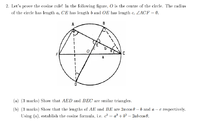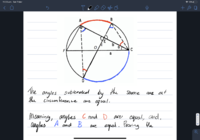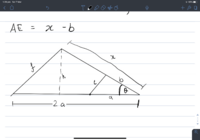You are using an out of date browser. It may not display this or other websites correctly.
You should upgrade or use an alternative browser.
You should upgrade or use an alternative browser.
Assignment help! Proving cosine rule
- Thread starter sharon101
- Start date
Steven G
Elite Member
- Joined
- Dec 30, 2014
- Messages
- 14,559
I understand that you are having trouble with this assignment. Can you please post your work so we can point out your mistake(s). please read the forum guidelines that state that you must be involved in solving your problems and that the helpers here will guide in the correct direction but will not do the problem for you.
Steven G
Elite Member
- Joined
- Dec 30, 2014
- Messages
- 14,559
Please state that the two triangles are similar so we can be done with part a!
So AE = something -b (the something is 2acos(theta)
Looking at the diagram it seems that AE = AC -b.
So now we have to show that AC = 2acos(theta). Can you try that?
So AE = something -b (the something is 2acos(theta)
Looking at the diagram it seems that AE = AC -b.
So now we have to show that AC = 2acos(theta). Can you try that?
pka
Elite Member
- Joined
- Jan 29, 2005
- Messages
- 11,974
To sharon101, I notice the you use the statement that two angles are equal. But that is impossible. If \(\angle ABC=\angle DEF\) that means they are the same angle. If the angles have the same measure,\(m(\angle ABC)=m(\angle DEF))\)[such as inscribed in the same circle intercepting the same arc.] then \(\angle ABC \cong \angle DEF\) i.e. are congruent not equal but of equal measure.I have this so far for a. no sure if this is in the right direction.
So far I have deduced this, not gotten very far, keep stumbling over myself. Been a few years since I have last done maths so can’t remember all my rules for angles and what not inside circles. I believe I am looking too far into it and it is an easy question but just don’t know what to go off. Thanks again
∠FAC at the circumference is subtended by diameter FC (or semicircle) and therefore equals 90°. This is a special case of the circle theorem which states the angle at the circumference subtended by an arc (in this case 90°) is half the angle at the centre subtended by the same arc. ( in this case 180°).
It follows ΔAFC is a right angled triangle.
Can you express cosθ in terms of AC and the diameter?
What does diameter equal in terms of a?
Now find AE in terms of a, cosθ and b.
What does BE equal in terms of a and c?
Since ΔAED ~ ΔBEC ratios of corresponding sides are equal.
⇒AE/BE = DE/EC where DE = a + c and EC = b
Using your answers to AE and BE see if you can crossmultiply the two fractions and come up with an expresssion which represents the cosine rule.
It follows ΔAFC is a right angled triangle.
Can you express cosθ in terms of AC and the diameter?
What does diameter equal in terms of a?
Now find AE in terms of a, cosθ and b.
What does BE equal in terms of a and c?
Since ΔAED ~ ΔBEC ratios of corresponding sides are equal.
⇒AE/BE = DE/EC where DE = a + c and EC = b
Using your answers to AE and BE see if you can crossmultiply the two fractions and come up with an expresssion which represents the cosine rule.
Last edited:
pka
Elite Member
- Joined
- Jan 29, 2005
- Messages
- 11,974
To hoosie, what does "∠FAC at the circumference" mean? If you want to contribute to geometry questions then please learn its vocabulary. Circumference is a number. It is twice the radius of a circle times \(\pi\). I think what you must mean is the \(\angle FAC\) has its vertex on the circle. Such an angle is known as an inscribed angle. Likewise the diameter of a circle is also a number, it is twice the radius of the circle. A length of a line segment having its end points on the circle and containing the centre has length equal to the diameter. There are some textbooks that define such a segment as a cord containing the centre.∠FAC at the circumference is subtended by diameter FC (or semicircle) and therefore equals 90°. This is a special case of the circle theorem which states the angle at the circumference subtended by an arc (in this case 90°) is half the angle at the centre subtended by the same arc. ( in this case 180°).
Steven G
Elite Member
- Joined
- Dec 30, 2014
- Messages
- 14,559
You are making this hard for yourself. In that last diagram you posted that top angle is a right angle!. Using that right triangle simply find the cos(\(\displaystyle \theta\))!
Delete ALL writing, lines etc (BUT NOT \(\displaystyle \theta\)) in that triangle and simply compute cos(\(\displaystyle \theta\)) using the labels for the sides you listed.
Delete ALL writing, lines etc (BUT NOT \(\displaystyle \theta\)) in that triangle and simply compute cos(\(\displaystyle \theta\)) using the labels for the sides you listed.
I agree pka that both diameter and circumference are measurements but I was using the first definition of each shown below:
Circumference:
1) the enclosing boundary of a curved geometric figure, especially a circle.
2) the distance around a body or figure, especially a circle or sphere.
Diameter of a circle:
1) any straight line segment that passes through the centre of the circle and whose endpoints lie on the circle. It can also be defined as the longest chord of the circle.
2) the distance from one side of the circle to the other through its centre.
I could have used the term inscribed angle but chose not to because I didn’t think it mattered. I think when it is said that an angle is at the circumference it is fairly obvious that the vertex of the angle lies on the circle. My preference for this terminology comes from its use in one of the circle theorems which states ‘the angle at the circumference subtended by an arc is equal to half the angle at the centre subtended by the same arc’. When comparing positions of the two angles it an be said one angle is at the centre (vertex at centre) and the other at the circumference (vertex on circle).
Circumference:
1) the enclosing boundary of a curved geometric figure, especially a circle.
2) the distance around a body or figure, especially a circle or sphere.
Diameter of a circle:
1) any straight line segment that passes through the centre of the circle and whose endpoints lie on the circle. It can also be defined as the longest chord of the circle.
2) the distance from one side of the circle to the other through its centre.
I could have used the term inscribed angle but chose not to because I didn’t think it mattered. I think when it is said that an angle is at the circumference it is fairly obvious that the vertex of the angle lies on the circle. My preference for this terminology comes from its use in one of the circle theorems which states ‘the angle at the circumference subtended by an arc is equal to half the angle at the centre subtended by the same arc’. When comparing positions of the two angles it an be said one angle is at the centre (vertex at centre) and the other at the circumference (vertex on circle).
Last edited:



